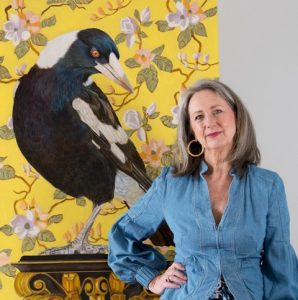
Painter Fiona Smith with one of her birds.
Fiona Smith grew up at Church Point, on the northern fringes of Sydney. Her mother was a potter who refused to give her daughters dolls but supplied as much paper and powdered paint as they could use. Her father, a craftsman and jack of all trades, made the first easel Fiona ever worked on.
Although she was always drawing and painting, it didn’t occur to Fiona that she could make a living as an artist, so she pursued a writing career. After graduating with a journalism degree, she blended shifts at a Sydney newspaper with classes at Julian Ashton Art School.
For a while, artmaking took a backseat to building her media career and raising a family. As Fiona’s two children became more independent, she joined an art class at the Willoughby Art Centre, where her mother had learned pottery when her own children were young. Signing up for workshops with the best exhibiting artists she could find was another investment in her art career.
Having held several solo shows and just exhibited at the Singapore Affordable Art Fair, we asked Fiona how she made the transition to full-time painting, where she seeks inspiration and how her exquisitely beautiful birds emerged as a predominant theme.
Interview by Lisa Doust
When did you start selling your work?
In 2018, four years after joining Willoughby Arts Centre, I started selling through a mixture of self-organised exhibitions and online galleries. Encouragingly, 60 pieces were sold in my first year. My employer made me redundant in 2016 and I slid easily into freelance writing. As art sales increased, I was able to drop the writing and am now painting full-time.
What is the best advice you were given in the early stages of your art career?
Kerrie Lester, a fantastic teacher, was determined that students should find their own subjects and style. She encouraged me to be bold, to not be precious and, most importantly, to have fun.
How did you arrive at your main subject matter?
Birds became a theme after I noticed enthusiastic interest in one of my paintings at an exhibition. It was a magpie with the pattern of my William Morris ‘Acanthus’ rug as the background. Two people fought to buy it and I had to paint a consolation maggie for the loser. “Hmmm, I’ll have to do some more,” I thought.
The birds are realistic but in manufactured settings, so maybe there is a touch of surrealism. I paint in oils and use a dagger-shaped brush for the feathers. I like challenging myself to paint an object and find ways to put a bird on it! I look for birds or furniture that make an interesting shape for a composition. Sometimes I am trying out ideas on colour harmony or tonal variation.
Where do you sell your work?
Mainly through Michael Reid Murrurundi and my art dealer, Sarah Birtles. When I began my art career, I believed galleries would not be interested in a middle-aged, second-career painter and that I would have to make my own way. I built up Instagram, sold through my website, staged exhibitions and used online art marketplaces – this worked so well that, in 2021, I had a sudden flurry of interest from galleries.
The galleries and Sarah Birtles take my art to collectors I can’t reach alone. They provide marketing expertise, handle sales and delivery, find opportunities for me and give me professional advice. That leaves me free to do the creative thing.
How do you market your work?
All my effort goes into Instagram. I don’t have the mental bandwidth for other platforms. I also benefit from the marketing nous of Sarah Birtles and the Michael Reid group.
What is the most challenging aspect of being a full-time artist?
Time. Every new painting seems to take more time, rather than less, and then the back-end stuff of being an artist chews up the hours.
Who or what are you most inspired by at the moment?
There are so many other artists whose work inspires me, and I want to surround myself with it. Lucy Culliton always inspires me. I love that she does not feel the need to conform and does whatever the hell she wants. Her generosity is also an inspiration.
I bought a little Lucy Roleff still life this year and keep peering closely at it to marvel at the detail. I have a Kean Onn See marmalade bottle artwork that glows when the morning sun hits it. I now have four Louise Frith paintings and must stop dropping into her studio, or she will ruin me!
Thinking about the business aspects of being an artist, what would you recommend anyone just starting out should focus on?
Getting their work out there. You should be showing it to people – even if it is not yet ready to be sold. Build your artist network and support each other. Share information generously. Be yourself.
Any further advice for artists wanting to attract attention?
Be active on social media, celebrate your sales (tactfully) and post your best work. Make supportive and insightful comments on gallery posts. Visit galleries, be charming and ask intelligent questions about the art without pushing your own. Have a business card with one of your best artworks on it.
Be professional and work on the presentation of your website and Instagram. Have excellent photos of your work and yourself, and have a body of work to show – at least 12 works that might look good together as an exhibition (in case a gallery offers you one).
FOR YOUR DIARY: Fiona has an online release of new work launching in February 2024 via sarahbirtles.com and her next solo show will be held at Michael Reid Murrurundi in May 2024.
Follow Fiona via @fionasmithartist or visit fionasmithart.com
